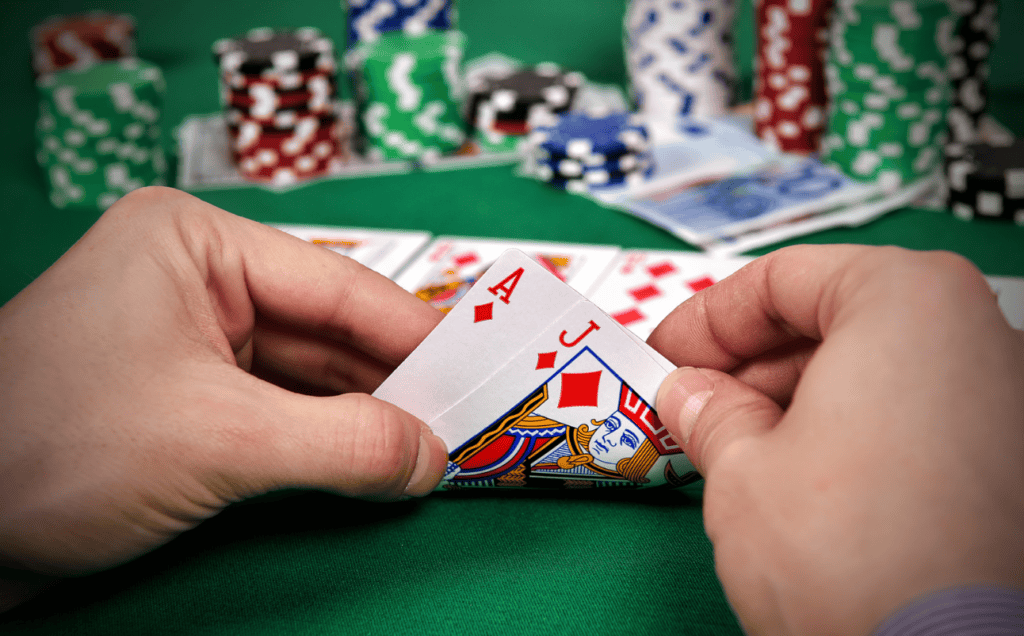Heads-up poker is a format where only two players compete against each other; this format differs from games with more participants due to the constant pressure and the necessity for a broad and aggressive range of play.
For instance, the induction of aggressive play is illustrated by the probability of both players being dealt pocket Aces—the best starting hand—in the same round, which stands at about 270,724 to 1.
This rarity underlines the game’s unpredictability and the need for psychological prowess in heads up poker play.
The Statistical Foundation of Heads-up Poker
Moreover, studies on the psychological elements of online poker reveal interesting dynamics, such as the influence of perceived gender on bluffing behavior. Research indicates that players bluff 6% more frequently at tables with female-only avatars than at those with male-only or mixed-gender avatars, pointing towards deep-rooted psychological biases and their exploitation thereof.
The importance of starting hands cannot be overstated in heads-up poker. The top five starting hands (AA, KK, QQ, JJ, TT) particularly increase a player’s chances of winning a hand, yet skilled players can win with a wide range of hands due to the psychological and strategic elements involved. This showcases the blend of luck and skill, with a strong emphasis on psychological manipulation and strategic flexibility.

Furthermore, the game’s high variance demands tremendous emotional tolerance. Players must steer the ups and downs of the game while making correct decisions, highlighting the essential nature of psychological resilience in heads-up poker. Emotional tolerance enables players to remain rational and strategic despite the inherent unpredictability and the potential for significant short-term losses.
The introduction of Game Theory Optimal (GTO) strategies through poker solvers represents complexity. These advanced algorithms, proven to outperform top human players in heads-up no-limit hold’em, underscore the strategic depth of heads-up play and the continuous evolution of strategies aiming at psychological dominance.
Reading Opponents and Adjusting Strategies
An integral component of mastering heads-up poker is the ability to read opponents and adapt strategies accordingly. This skill is particularly paramount in live settings where observing physical tells—unconscious behaviors or reactions that can indicate a player’s hand strength—can provide critical insights. Experienced players learn to differentiate between genuine tells and deceptive signals, providing an edge that transcends mere statistical strategies.
The average voluntarily put money in pot (VPIP) stat for an online heads-up professional, which stands at around 70%, elucidates the aggressive nature of successful heads-up play. Players engage with a substantially higher percentage of hands than in games with more participants, showcasing the importance of adaptability and psychological acuity.
Continuation betting, or c-bet percentages, further highlight the strategic differentiation in heads-up play. With recommended percentages ranging widely based on one’s position (50-70% when in position and 0-30% out of position), players must constantly adapt their strategies based on their and their opponent’s actions. This adaptability not only involves statistical acumen but also a deep understanding of the psychological underpinnings of aggression and passivity.
An analysis of over a million hands demonstrates that the best heads-up players maintain a positive win rate, with a big blind won per 100 hands rate of around 10. This metric signifies not only skill in selecting and playing hands but also a psychological edge that enables these players to outmaneuver their opponents consistently.
In heads-up poker situations, players find themselves always “in late position,” suggesting a vastly different strategic approach than full ring games. This positioning influences their hand selection, aggression levels, and psychological tactics. They exploit a wide range of starting hands, understanding that the power of a hand in heads-up play greatly depends on psychological warfare and less on the hand’s inherent strength.
The psychological warfare in heads-up poker is evident in the dynamics of bluffing, emotional control, strategic flexibility, and the constant readjustment to the opponent’s strategies. Whether a player succeeds in this high-stakes environment largely depends on their ability to master these psychological aspects, making heads-up play a compelling examination of human behavior and strategic thinking.
Expanding the Insights into Heads-up Poker Psychology
While the foundational principles of heads-up poker psychology are well-established, delving deeper into specific psychological dynamics can provide valuable insights for players seeking to elevate their game to the next level.
One such dynamic is the concept of tilt, a state of emotional frustration or agitation that can impair a player’s decision-making ability. Understanding how to recognize and manage tilt is crucial for maintaining composure and making rational decisions during intense heads-up matches. Techniques such as mindfulness meditation and deep breathing exercises can help players regain focus and control when faced with challenging situations.
Another psychological aspect to consider is the role of confidence in heads-up poker. Confidence can influence a player’s demeanor, betting patterns, and overall strategy. Players who exude confidence may intimidate their opponents and gain a strategic advantage, while those lacking confidence may become more predictable and susceptible to exploitation. Cultivating confidence through practice, study, and positive reinforcement can enhance a player’s performance in heads-up poker.

Additionally, the concept of psychological warfare extends beyond bluffing and aggression to include subtle forms of manipulation and deception. Players may use body language, verbal cues, and timing tells to convey false information or mislead their opponents. Recognizing and deciphering these psychological signals can give players a strategic edge and help them make more informed decisions at the table.
Furthermore, understanding the psychological profiles of different opponents can inform strategic adjustments and counter-strategies. Some players may be prone to aggression, while others may be more passive or risk-averse. By analyzing opponents’ playing styles, tendencies, and behavioral patterns, players can tailor their approaches to exploit weaknesses and capitalize on opportunities effectively.
In conclusion, while technical proficiency is essential in heads-up poker, mastering the psychological aspects of the game can provide a significant competitive advantage. By expanding their understanding of tilt, confidence, psychological manipulation, and opponent profiling, players can refine their strategies, improve their decision-making, and ultimately achieve greater success in heads-up poker.


